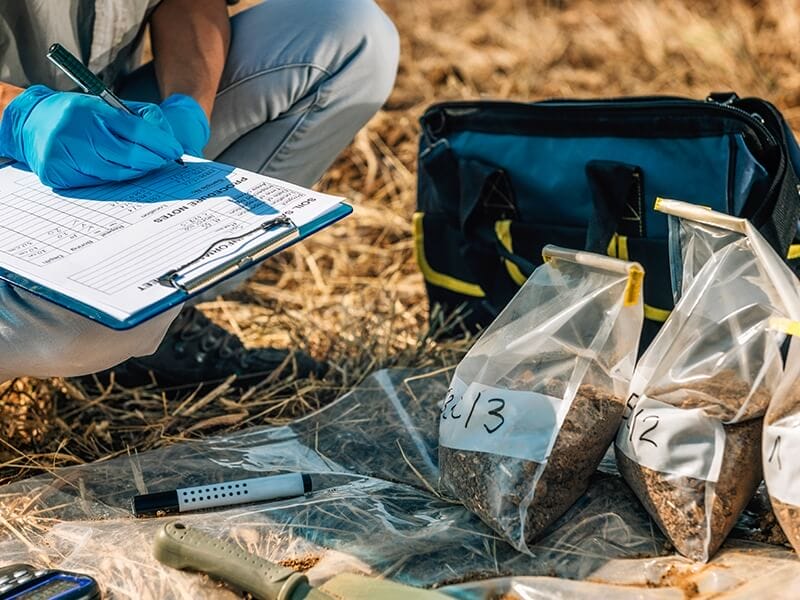
Detecting VOCs In Soil
Soil analysis for volatile organic compounds VOCs
VOCs enter soil from many sources including, from the atmosphere by wet or dry deposition (typically rainfall or deposition of ash and particulate smog), as liquids and solids as a result of petrochemical spillage and leakage and clandestine dumping of waste, from deliberate spreading of waste products as an intended improvement to soil health (e.g. sewage sludge, composted domestic waste), and run off of contaminated surface water from asphalted and paved surfaces. Soil biota produce large quantities of methane, but not other VOCs.
Soil Screening For VOCs By Headspace Measurements
Soil analysis for volatile organic compound (VOCs) requires careful sample retrieval handling. For most VOCs, it is often possible and advantageous to analyse a sample headspace.
Soil analysis for VOCs requires careful sample retrieval handling. Gas chromatography Is used to separate sample VOCs from sampled soil. For most VOCs, it is often possible and advantageous to analyse a sample headspace. Screening of a soil samples may be used to determine whether this or a more sensitive technique is deployed in soil analysis. Soil screening by PID exploits the strengths of this technique.
”Wherever VOCs are prospective contaminants, soil analysis requires special procedures to prevent VOC loss. Sample collection is undertaken quickly, using awls which are least likely to disturb the soil matrix. Samples are placed in (preferably) glass containers and hermetically sealed promptly. Within 48 hr, soils are treated with methanol or acid to prevent biodegradation of VOCs, and then refrigerated, and even then, for only up to 14 days before analysis.
‘Region 9 Technical Guidelines for Accurately Determining Volatile Organic Compounds (VOC) in Soil and Solid Matrices’, R9QA/05.2, US EPA, 2005.
Analysis Of Volatile Organic Compounds (VOC) In Soil
Soil analysis is undertaken with a view to targeting specific soil variables, which may include a range or very specific VOC contaminants. Initially, a preliminary site investigation – an interrogative survey – is undertaken to establish the likely extent and nature of prospective contamination. On the basis of the preliminary survey, a comprehensive survey is undertaken, involving soil analysis from specified locations.
Soil Screening For VOCs By Headspace Measurements
Many causes of VOC introduction into soil, such as water run-off,
leakage and dumping are highly localised. This invites the possibility of soil screening during a preliminary site survey, which ensures all known factors are considered in ‘scoping out’ the prospective contamination of a site. From screening data, it is possible to commit to comprehensive analysis of a far greater proportion of samples for which VOC content is high. Although indicative, by identifying locations of high contamination for more comprehensive analysis sampling, soil screening often delivers a much more comprehensive evaluation of soil contamination for a given investigative cost. The cost, portability, robustness, broad sensitivity to VOCs, ease of field use, and rapid and dynamic range of measurement of photoionisation detection (PID) strongly favour it as a means of soil screening. PIS is prescribed in the screening of soil headspace in the US EPA method 3815.
Soil analysis for VOCs requires careful sample retrieval handling. Gas chromatography Is used to separate sample VOCs from sampled soil. For most VOCs, it is often possible and advantageous to analyse a sample headspace. Screening of a soil samples may be used to determine whether this or a more sensitive technique is deployed in soil analysis. Soil screening by PID exploits the strengths of this technique. It is also used to determine areas worthy of more or less intense soil surveyance. The procedures for screening in this ‘exploratory way’ are not widely documented. As with any other VOC in soil analysis, samples of PID headspace screening can and should be handled with a view as to reliable VOC retention in sample containers, reliable VOC partitioning in the sample headspace, and consistent sampling by PID. The use of PID which is resilient to variable water content is to be strongly recommended for soil screening. An example of this would be the MiniPID 2 PPM Gas Sensor.
Download our FREE Guide
“Soil Screening For VOCs By Headspace Measurements”
The soil screening for VOCs by headspace measurement guide which can be downloaded below provides the reader with an in-depth balance of knowledge of Soil analysis which is undertaken with a view to targeting specific soil variables, which may include a range or very specific VOC contaminants. Initially, a preliminary site investigation – an interrogative survey – is undertaken to establish the likely extent and nature of prospective contamination. On the basis of the preliminary survey, a comprehensive survey is undertaken, involving soil analysis from specified locations.























